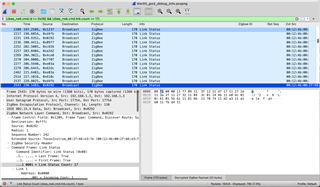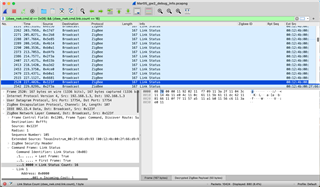Other Parts Discussed in Thread: Z-STACK
Hello,
We have a network that has a coordinator and about 30 routers, and we defined the MAX_NEIGHBOR_ENTRIES value to 16. We are using the SimpleLink CC13x2 26x2 SDK 4.20.01.04 stack.
In our sniffer traces however, we see that some routers are sending link status messages with 16 addresses in the neighbor list, but some routers are sending link status messages with 17 addresses. (About 46% of the router link status messages have 17 addresses and 54% have 16 addresses.) All of the link status messages (except for those coming from one router) have the coordinator as the first address. But, if I look at the second address in the link status messages, it varies between at least 6 different addresses across routers.
Given these observations, we have two questions.
- Why do some routers send 17 addresses in their link status messages if the neighbor table size is 16? We would expect all routers to have a consistent maximum number of addresses in the link status messages, so it is weird that the number of listed neighbors can be either 16 or 17. How does the stack get the link quality information for the 17th address if it can’t fit in our neighbor table?
- There seems to be some logic that tries to include the coordinator in the neighbor table, or at least, in the list of link status addresses. If the NT selection algorithm was not somehow favoring the coordinator’s address, then the first entry in the sorted list of link status addresses should not always be the coordinator’s address. It should be a low address, but there should be some variability among different routers - similar to how the second index looks. But they all consistently list the coordinator’s address in their link status address list. Any ideas why this is happening?
Related to question #2, our coordinator sends application broadcast commands into the network, say every 30 seconds or so. We have done some limited testing where we have removed the coordinator from the neighbor table on some routers. But it seems that the coordinator’s address is getting inserted back into the link status list shortly after the router receives a broadcast application packet from the coordinator. To our knowledge, we have not written or enabled any code that would modify the neighbor table (other than one test condition that removes the coordinator from the neighbor table).
Thank you in advance!



